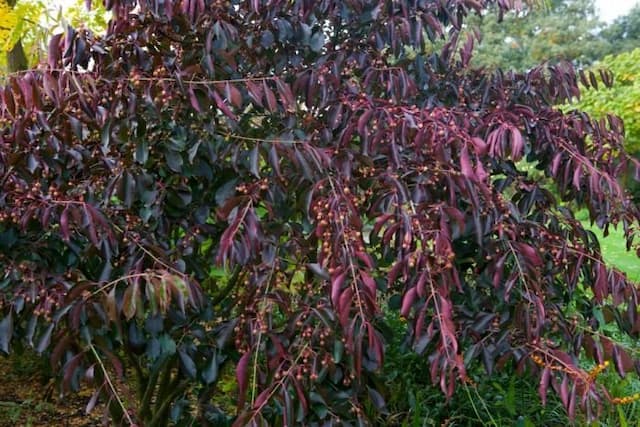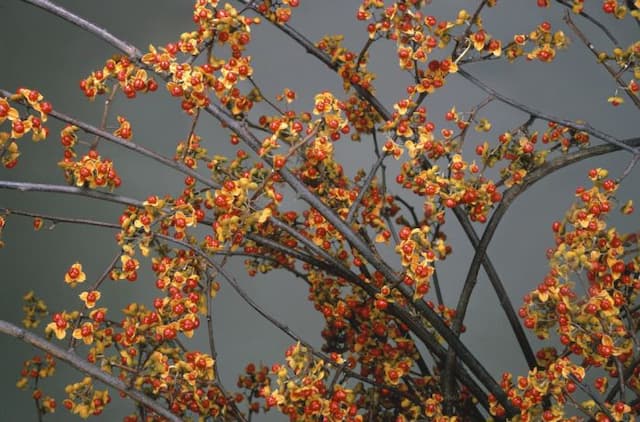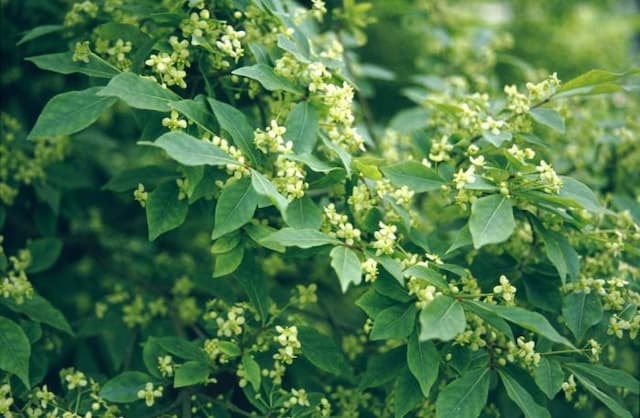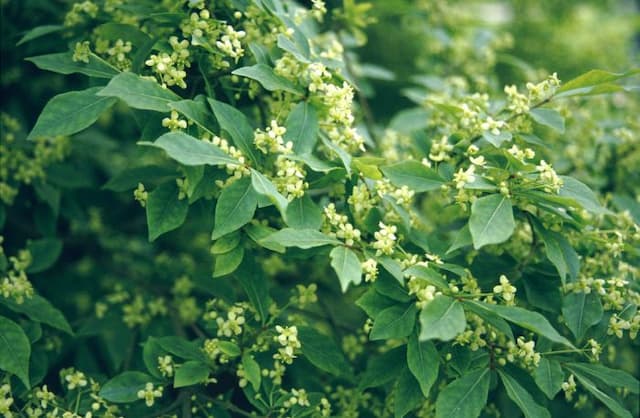Spindle 'Emerald Gaiety' Euonymus fortunei 'Emerald Gaiety' (v)

ABOUT
'Emerald Gaiety' is a small, bushy evergreen shrub, but climbing if planted against a wall. Leaves rounded, with an irregular white margin, tinged pink in winter; rarely flowers
About this plant
 Names
NamesSynonyms
Wintercreeper, Fortune's Spindle, Emerald Gaiety Euonymus.
Common names
Euonymus fortunei 'Emerald Gaiety'
 Characteristics
CharacteristicsLife cycle
Perennials
Foliage type
Evergreen
Color of leaves
Variegated
Height
4 feet (1.22 meters)
Spread
4 feet (1.22 meters)
Plant type
Shrub
Hardiness zones
5
Native area
China Korea
Benefits
 General Benefits
General Benefits- Low Maintenance: This plant is relatively easy to care for and requires minimal upkeep once established.
- Versatile Use: It can be utilized in various landscape designs, including as ground cover, in containers, or as a climber on structures.
- Year-Round Interest: The 'Emerald Gaiety' offers visual appeal throughout the year with its evergreen variegated leaves and sometimes pink-tinged winter foliage.
- Drought Tolerance: Once established, it has a degree of drought resistance making it suitable for gardens with less water availability.
- Frost Hardy: It is capable of withstanding cold temperatures, which makes it suitable for many climates.
- Attractive to Wildlife: The plant can provide shelter and occasionally berries that are attractive to birds.
- Soil Adaptability: It is able to grow in a range of soil types as long as they are well-drained.
- Urban Tolerant: The plant is quite tolerant to urban pollution, which makes it suitable for city landscapes and roadside plantings.
- Fast Growing: With a relatively quick growth rate, it can quickly fill in spaces in the garden.
- Compact Size: Due to its moderate size, it is appropriate for smaller gardens or spaces where a large, dominating plant wouldn't be suitable.
 Medical Properties
Medical PropertiesThis plant is not used for medical purposes.
 Air-purifying Qualities
Air-purifying QualitiesThis plant is not specifically known for air purifying qualities.
 Other Uses
Other Uses- Euonymus fortunei 'Emerald Gaiety' can be used to create intricate topiary shapes in gardens due to its dense foliage and ability to tolerate heavy pruning.
- Wintercreeper can be trained to grow on trellises or arbors, providing a lush green backdrop for garden spaces even in the colder months.
- Although not commonly used for this purpose, the vibrant green and white variegated leaves can be included in floral arrangements for contrast and texture.
- The dense growth habit of Wintercreeper makes it an effective ground cover to prevent soil erosion on slopes or banks.
- Wintercreeper's foliage can be used in crafts, such as wreath-making, to add a variegated green element to the design.
- The plant can also serve as a living mulch, suppressing weeds and retaining soil moisture when planted densely in garden beds.
- The sturdy branches of Wintercreeper can be used as natural fencing or screens for added privacy in landscaped areas.
- In larger urban areas, Wintercreeper can help reduce noise pollution when planted densely along highways or property boundaries.
- As a tough, resilient plant, Wintercreeper can be used in reclamation projects to help stabilize and beautify disturbed land areas.
- Some crafters use the dried stems and leaves of Wintercreeper for creating decorative potpourri mixes due to their interesting shapes and color.
Interesting Facts
 Feng Shui
Feng ShuiThe Wintercreeper is not used in Feng Shui practice.
 Zodiac Sign Compitability
Zodiac Sign CompitabilityThe Wintercreeper is not used in astrology practice.
 Plant Symbolism
Plant Symbolism- Endurance: Euonymus fortunei 'Emerald Gaiety', commonly known as Wintercreeper, typically represents endurance due to its hardy nature and ability to thrive in various conditions, symbolizing the resilience necessary to endure challenges in life.
- Adaptability: Wintercreeper's capability to adapt to different environments, growing as a ground cover or climbing vine, signifies the importance of adaptability and versatility in overcoming obstacles.
- Longevity: As an evergreen plant, Wintercreeper reflects the concept of everlasting life or immortality, often associated with the continuity and permanence seen in enduring relationships or legacies.
 Water
WaterWintercreeper should be watered deeply, but infrequently, to encourage the roots to grow deeper into the soil. During the first growing season, aim to water the plant once a week with approximately 1 to 1.5 gallons of water, ensuring the soil is moist but not waterlogged. Once established, watering can be reduced to every two to three weeks, depending on the climate and soil conditions. During hot, dry spells, additional water may be necessary. Always check the soil moisture level a few inches below the surface before watering to avoid overwatering.
 Light
LightWintercreeper thrives in a variety of light conditions but does best in partial to full sun. While it can tolerate full shade, the variegation of 'Emerald Gaiety' may not be as pronounced. The ideal spot would provide the plant with morning sunlight and afternoon shade to protect it from the intense heat of the day.
 Temperature
TemperatureWintercreeper is hardy and can tolerate a broad range of temperatures, from as low as -20 degrees Fahrenheit in winter to as high as 80 degrees Fahrenheit in summer. The ideal temperature for promoting growth and maintaining health is between 50 and 70 degrees Fahrenheit. This plant is quite adaptable and can survive occasional temperature extremes beyond these ranges.
 Pruning
PruningWintercreeper should be pruned to maintain its shape and size as well as to encourage healthy, dense growth. The best time to prune is in late winter or early spring before new growth begins. Pruning can be done annually or as needed, depending on the growth rate and desired appearance. When pruning, always use clean, sharp tools to make precise cuts.
 Cleaning
CleaningAs needed
 Soil
SoilWintercreeper thrives in well-draining soil with a pH of 6.0 to 7.5. A mix containing loam, peat, and sand or perlite is ideal, ensuring nutrients and proper aeration. Regular garden soil amended with organic matter works well too.
 Repotting
RepottingWintercreeper doesn't require frequent repotting and can often be repotted every 2 to 3 years as it is a slow grower. Check the roots annually, and repot in spring if they are crowded.
 Humidity & Misting
Humidity & MistingWintercreeper is versatile and tolerates a wide range of humidity levels but prefers average to high humidity, avoiding extremely dry conditions which can damage the foliage.
 Suitable locations
Suitable locationsIndoor
Place in bright, indirect light and well-draining soil.
Outdoor
Plant in partial to full sun and mulch to retain moisture.
Hardiness zone
5-9 USDA
 Life cycle
Life cycle'Emerald Gaiety' wintercreeper (Euonymus fortunei 'Emerald Gaiety') begins its life cycle when seeds germinate in early spring, often after a period of stratification which is a cold treatment to mimic winter conditions. After seedlings emerge, they grow into juvenile plants with a trailing habit, which then gradually develop into mature, evergreen shrubs with a dense, bushy form. The plant produces small, inconspicuous, greenish-white flowers typically in early summer, though flowering is often sparse and can sometimes go unnoticed. Following flowering, if pollination occurs, the plant will produce pink to red, capsule-like fruits that contain seeds, though 'Emerald Gaiety' is not predominantly propagated by seed. The shrub can also reproduce vegetatively through stem cuttings or layering, where stems touching the ground develop roots and give rise to new plants. Under favorable conditions, 'Emerald Gaiety' can live for many years, forming extensive ground cover or climbing structures with the help of aerial rootlets.
 Propogation
PropogationPropogation time
Spring-Early Summer
The most popular method of propagation for the Euonymus fortunei 'Emerald Gaiety', also known as the Wintercreeper, is through semi-hardwood cuttings. This is typically done in late summer. To propagate, one would cut a 4 to 6-inch (10 to 15 centimeters) length of semi-hardwood, which is a stem that is partly, but not fully mature and woody. The leaves on the lower half of the cutting should be removed, and the raw end can be treated with rooting hormone to encourage root development. This prepared cutting is then inserted into a pot filled with a well-draining soil mix, ensuring that the node where the leaves were removed is buried in the soil. The pot should be kept in a warm, humid environment with indirect sunlight, and the soil should be consistently moist but not soaked to nurture the cutting until roots develop, after which it can be transplanted.







